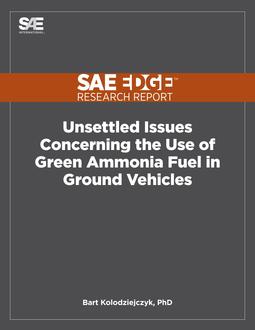Description
While hydrogen is emerging as a clean alternative automotive fuel and energy storage medium, there are still numerous challenges to implementation, such as the economy of hydrogen production and deployment, expensive storage materials, energy intensive compression or liquefaction processes, and limited trial applications. Synthetic ammonia production, on the other hand, has been available on an industrial scale for nearly a century. Ammonia is one of the most-traded commodities globally and the second most-produced synthetic chemical after sulfuric acid. As an energy carrier, it enables effective hydrogen storage in chemical form by binding hydrogen atoms to atmospheric nitrogen.
While ammonia as a fuel is still in its infancy, its unique properties render it as a potentially viable candidate for decarbonizing the automotive industry. Yet, lack of regulation and standards for automotive applications, technology readiness, and reliance on natural gas for both hydrogen feedstocks to generate the ammonia and facilitate hydrogen and nitrogen conversion into liquid ammonia add extra uncertainty to use scenarios.
Unsettled Issues Concerning the Use of Green Ammonia Fuel in Ground Vehicles brings together collected knowledge on current and future prospects for the application of ammonia in ground vehicles, including the technological and regulatory challenges for this new type of clean fuel.
Product Details
- Edition:
- 1
- Published:
- 02/15/2021
- Number of Pages:
- 26
- File Size:
- 1 file , 2.9 MB
- Note:
- This product is unavailable in Belarus, Russia, Ukraine






